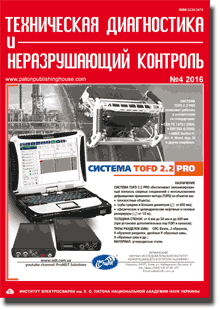| 2016 №04 (02) |
DOI of Article 10.15407/tdnk2016.04.03 |
2016 №04 (04) |

Техническая диагностика и неразрушающий контроль, №4, 2016 стр. 14-20
Моделирование процессов зарождения и развития докритической поврежденности металла сварных трубопроводных элементов при малоцикловом нагружении
Е. А. Великоиваненко, А. С. Миленин, Г. Ф. Розынка, Н. И. Пивторак
E.O. Paton Electric Welding Institute, NASU
Реферат:
Разработан комплекс математических моделей и программных средств их реализации для численного прогнозирования совместных процессов термодеформирования и докритического разрушения металла ответственных сварных конструкций в условиях сварки и под действием переменного силового воздействия. Предложены критерии зарождения микро- и макроразрушения при пластическом течении материала по вязкому и хрупко-вязкому механизмам. На примере элементов трубопроводов с изолированными и множественными дефектами коррозионного утонения стенки в области монтажной (ремонтной) сварки исследованы особенности зарождения и развития докритического разрушения под действием малоциклового внешнего силового воздействия. Библиогр. 20, рис. 7.
Ключевые слова: докритическое повреждение, вязкое разрушение, ультрамалоцикловая и малоцикловая усталость, трубопроводный элемент, монтажная и ремонтная сварка
A set of mathematical models and their implementation software was developed for numerical prediction of joint processes of thermal deformation and subcritical fracture of metal in critical welded structures in welding and under variable force impact. Criteria of micro- and macrofracture initiation at plastic flow of material by ductile and brittle-ductile mechanisms are proposed. Features of initiation and propagation of subcritical fracture at low-cycle external force impact were studied in the case of pipeline elements with isolated and multiple defects of corrosion wall thinning in the area of erection (repair) welding. 20 References, 7 Figures.
Keywords: Subcritical damage, ductile fracture, ultralow-cycle and low-cycle fatigue, pipeline element, erection and repair welding
1. Lam, C., Zhou, W. (2016) Statistical analyses of incidents on onshore gas transmission pipelines based on PHMSA database. Pressure Vessels and Piping, 6, 1–56. https://doi.org/10.1016/j.ijpvp.2016.06.003
2. Wintle, B., Kenzie, B. W., Amphlett, G. J. et al. (2003) Best practice for risk based inspection as a part of plant integrity management: Contract research report 363/2001 Merseyside, Health and Safety Executive.
3. Escoe, A. K. (2006) Piping and pipelines: Assessment Guide. Texas, Gulf Professional Publishing.
5. Klingbeil, D., Svendsen, B., Reusch, F. (2016) Gurson-based modeling of ductile damage and failure during cyclic loading processes at large deformation. Engineering Fracture Mechanics, Vol. 160, 95–123. https://doi.org/10.1016/j.engfracmech.2016.03.023
6. Portnykh I. A., Panchenko, V. L. (2016) Characteristics of radiation porosity and structural phase state of reactor austenitic 07C–16Cr–19Ni–2Mo–2Mn–Ti–Si–V–P–B steel after neutron irradiation at a temperature of 440 ... 600 C to damaging doses of 36–94 dpa. The Physics of Metals and Metallography, Vol. 117, Is. 6, 611–623. https://doi.org/10.1134/S0031918X16060090
7. (2000) Fitness-for-Service. American Petroleum Institute: Recommended Practice 579. 1st ed. Washington, API Publications and Distribution.
8. (2008) DSTU-N B V.2.3-21:2008: Guidelines. Determination of residual strength of main pipelines with defects. Kyiv, Minregiondub [in Ukrainian].
9. Velikoivanenko, E.A., Rozynka, G.F., Milenin, A.S. et al. (2015) Evaluation of operability of the main pipeline with local wall thinning at repair by arc surfacing. The Paton Welding J., 1, 22–27. https://doi.org/10.15407/tpwj2015.01.03
10. Velikoivanenko, E.A., Rozynka, G.F., Milenin, A.S. et al. (2013) Modelling of processes of nucleation and development of ductile fracture pores in welded structures. Ibid., 9, 26–31.
11. Lemaitre, J., Desmorat, R., (2005) Engineering damage mechanics. Ductile, creep, fatigue and brittle failures. Berlin, Springer-Verlag.
12. Xue, L. (2008) A unified expression for low cycle fatigue and extremely low cycle fatigue and its implication for monotonic loading. Int. J. Fatigue, Vol. 30, 1691–1698. https://doi.org/10.1016/j.ijfatigue.2008.03.004
13. Frolov, V. (1988) Theory of welding processes. Moscow, Vysshaya Shkola [in Russian].
14. Xue, L. (2008) Constitutive modeling of void shearing effect in ductile fracture of porous materials. Engineering Fracture Mechanics, 75, 3343–3366. https://doi.org/10.1016/j.engfracmech.2007.07.022
15. Needleman, A. (1972) Void growth in an elastic-plastic medium. J. of Applied Mechanics, 39, 964–970. https://doi.org/10.1115/1.3422899
16. Huh, H., Kang, W. J. (2002) Crash-worthiness assessment of thin-walled structures with the high-strength steel sheet. Int. J. of Vehicle Design, 30(1-2), 1–21. https://doi.org/10.1504/IJVD.2002.002022
17. Karzov, G.P., Margolin, B.Z., Shvetsova, V.A. (1993) Physico-mechanical modeling of fracture processes. St.-Petersburg, Politekhnika [in Russian].
18. Makhnenko, V.I. (1976) Computational methods of investigation of welding stress and strain kinetics. Kiev, Naukova Dumka [in Russian].
19. Makhnenko, V.I. (2006) Resource of safe operation of welded joints and units of modern structures. Kiev, Naukova Dumka [in Russian].
20. (1967) Physical properties of steels and alloys applied in power engineering. In: Refer. Book. Ed. by B.E. Neumark. Moscow; Leningrad, Energiya
Поступила в редакцию 18.10.2016
Подписано в печать 3.11.2016
